The Chevy Cruze was the last man standing – so to speak.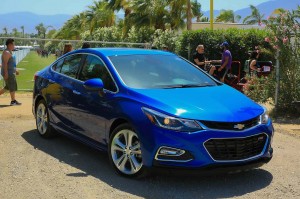
It was the only other affordable diesel-powered car you could buy … other than VW’s diesel-powered cars.
Which you can’t buy anymore.
At least not now.
Not until Uncle says ok. Which he may never.
That left the Cruze diesel. It cost more than its VW equivalent – the Jetta TDI – but it cost a lot less than any diesel-powered Audi, Mercedes or BMW.
Which are now the only other diesel-powered cars you can buy in the United States. Because the new Cruze comes only with a gas engine – at least for now.
GM says the diesel option will return – maybe for 2017.
Not because I doubt GM but because I know Uncle. He has made it hard to put together an affordable diesel-powered car; one that makes economic sense. His emissions fatwas – chasing ever-diminishing returns at ever-higher-cost – have made diesels expensive to buy and less fuel-efficient to drive.
That makes them a hard sell to the people who shop family cars like the Cruze (and Jetta). If the diesel engine costs too much to buy relative to what it saves them on fuel, they probably won’t buy it.
Which may be why GM will ultimately decide against selling a diesel powered version of the Cruze.
We’ll see.
What’s for-sure is a hatchback (five-door) version – definitely on deck for 2017. Also, turbo (gas) power is now standard – as is much-improved standard acceleration.
As well as a much roomier back seat, a larger-than-most (14 cubic foot) trunk) and a lower-than-most starting price, too.
The Cruze is Chevy’’s compact sedan – soon (2017) to be available as a hatchback sedan as well.
Like some others, it has grown such that it is almost mid-sized now. At least in terms of the space inside.
For the moment, the Cruze is only available with one engine – a turbocharged 1.4 liter gasoline engine. The formerly standard non-turbo gas engine has been retired – and the formerly optional turbo-diesel engine is at least temporarily no longer available.
Prices start at $16,620 for the base L trim with a six-speed manual transmission. This version of the Cruze is the most affordable car in this class – but it comes only with a manual.
If you want an automatic, you will need to step up to the LS trim, which starts at $19,120 (with the automatic).
With the manual, the LS trim stickers for $18,120.
The next-highest LT trim starts at $19,820 for one with a manual and $21,120 for the same car with the automatic.
A top-of-the-line Premier trim – which comes only with the automatic – stickers for $23,120.
Cross-shops include other compact sedans like the Ford Focus, Mazda3 and Honda Civic.
The Cruze is all-new for the 2016 model year. Re-bodied, lighter, roomier, quicker – and easier on gas.
Later in the calendar year, a hatchback sedan will join the lineup and – hopefully – the 2.0 liter turbo-diesel engine that was optional last year will be returned to the lineup.
WHAT’S GOOD
Formerly extra-cost “Eco” turbo engine is now standard.
Available 8-inch LCD touchscreen is larger than most others in this class; all trims get at least a 7-inch screen and Apple CarPlay and Android Auto are included with both, too.
Available wireless phone charger.
Has almost 3 inches more backseat legroom than Focus.
Costs $2,020 less to start than Civic sedan; $1,225 less to start than Mazda3 sedan.
WHAT’S NOT SO GOOD
Base price is a deal – unless you want an automatic transmission. If you do, it’s a $2,500 bump up to the LS trim.
Diesel engine is on possibly permanent hiatus.
Auto stop-start system (standard with the automatic transmission) has no off button.
Cruise control and wireless charger not offered with the lower-cost trims.
Previously, the Cruze was available with three engines, two gas (one of them turbocharged) and one turbo-diesel.
That’s been winnowed down to just one – for now.
It’s the previously optional 1.4 liter “Eco” engine, which returns as the new Cruze’s standard engine.
It’s a small engine – made bigger on demand via the turbocharger bolted to it. You may have noticed such engines proliferating like dandelions after a spring rain. It’s because of pressure being applied by Uncle to the car companies to squeeze more MPGs out of their engines without disappointing buyers – who still expect the engine to do something (other than make sad sounds) when they push down on the accelerator.
Smaller engines use less fuel (all else being equal) when they are idling in traffic or the driver isn’t demanding much from them in the way of acceleration.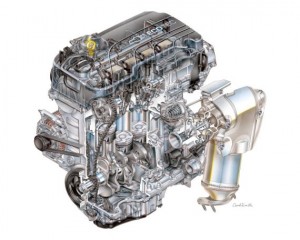
So replacing the formerly standard 1.8 liter engine with a smaller 1.4 liter engine helps Chevy make Uncle happy.
Adding the turbocharger makes you – the buyer – happy.
Without it, the little-engined Chevy would make sad sounds – and not do much else – when you push down on the accelerator pedal.
Because of the turbo, the little 1.4 engine makes more power than the previously standard (and not-turbocharged) 1.8 liter four: 153 hp (and 177 ft.-lbs. of torque) vs. 138 hp (and 125 ft.-lbs. of torque). This improves the performance of the car – zero to 60 is achieved in about 7.6 seconds now vs. 9.2 with the retired 1.8 liter engine, making the ’16 Cruze the quickest cars in its class with its standard engine.
Rivals like the Honda Civic and Mazda3 are quicker – but only when ordered with their optional engines. 
Fuel economy is much improved, too. 29 city, 41 highway with the manual transmission vs. 25 city, 36 highway for the old car wit the 1.8 liter engine and manual transmission.
With the optional six-speed automatic, the numbers notch up to 31 city, 42 highway.
Here again the Cruz outperforms its rivals, especially when you compare standard engines – and particularly when you compare the Chevy’s numbers with rivals like the Ford Focus (reviewed here) equipped with its standard manual transmission. It delivers a pretty mediocre 26 city, 36 highway. It’s better – MPG-wise – with the optional automatic. But then the Ford is much less quick (9-plus seconds to 60).
Given the Chevy’s lowest-in-class starting price (just over $16k with the manual) it makes a strong case for itself as the economical choice of the bunch – with the zippy acceleration being an added plus.
The mileage doesn’t go down – nor the performance. But the price goes up.
By $2,500 to just over $19k.
While that’s not high relative to the MSRPs of rivals when ordered with automatics, it’s not as much of a deal as the manual-equipped Cruze is.
Which brings us to the diesel engine – which (for now) is on leave.
Will it return?
Maybe.
My bet is it won’t. Here’s why.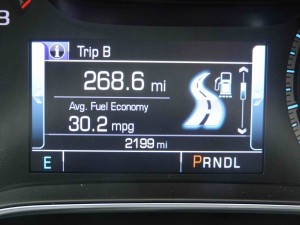
In the old Cruze (reviewed here) the diesel – a 2.0 liter engine – delivered 33 city, 46 highway. These are excellent numbers. But re-read the numbers of the gas-engined 2016 Cruze, which are also excellent.
The difference is 4 MPG in city driving and 5 MPG on the highway.
Now consider the likely cost of a diesel-powered Cruze.
The old model stickered for $24,855 – about $5k more than the old Cruze with the then-optional Eco engine.
What will the new Cruze sticker for with diesel power – especially given Uncle’s latest emissions fatwas, which have made it more expensive to sell a diesel-powered car in this country? The new diesel-powered Cruze will likely have to have both a particulate trap and a urea-injection system to make Uncle happy.
But the price may not make potential buyers happy. Particularly given the relatively slight mileage advantage. And given the higher cost of diesel fuel (also due to Uncle).
The new Cruze is lighter than the old model – and that could help, MPG-wise.
Another and much bigger help would be if Chevy offered a no (or fewer) frills version of the Cruze with the diesel engine. The previous Cruze diesel came loaded with extras like heated seats and a premium interior, 17-inch wheel and tire package, etc. All of which ar every nice to have if you want them and don’t mind paying for them, but which raise the price and thereby undercut the economic argument for the car.
My recommendation to Chevy would be to offer the diesel as a stand-alone option for the base L trim, which ought to make it possible to sell the car for about $22k. Make it available in other trims as well – for those who want the extras.
But make it possible to buy a diesel Cruze without them.
Now that VW is pretty much benched, it would leave Chevy as the only purveyor of an affordable diesel-powered car.
Here’s to hoping.
The good old days weren’t always good.
Economical cars were invariably slow cars. If you wanted speed, you lost mileage. Or you paid more.
There was always a catch.
This Chevy hasn’t got hidden strings – except perhaps the possibility that, eventually, the turbo-goosed engine may prematurely gray. This has been true in the past – and may be true in the future. Turbocharged engines have more parts and are higher-strung.
They are pressurized, after all.
But no one will be able to say until we get there.
And turbocharging is The Future – unless Uncle eases off. It’s the only way to make the CAFE cut without also cutting the power/performance of cars.
What can be said for certain is that the Cruze is quick – as quick as the Mazda3 with its optional engine (7.5 seconds to 60). It blows the doors off the base-engined Ford Focus (9.2 seconds to 60).
For that, we must pay homage to the turbo.
And also to Chevy, for slicing off about 100 pounds of curb weight. The ’16 weighs just under 3,000 pounds (2,944 lbs. to be precise) while the previous Cruze weighed just over 3,000 pounds (3,084).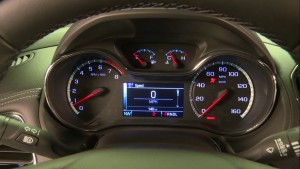
The turbo engine works just as well with the automatic as the manual and its torque peak (just 2,000 RPM) is almost diesel-like.
This is the other perk of turbocharging.
You get a nice dose of high-RPM power for the all-out effort (when necessary) but it isn’t necessary to beat on the engine (via the accelerator pedal) to get some action out of it. The Cruze is thus a very pleasant Traffic Car. With the lungs to break away from traffic when the need arises. 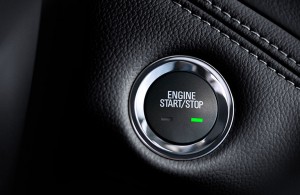
I am not a fan, though, of the obnoxious auto-stop/start system that you can’t say No Thanks to if you want the optional automatic. These systems automatically kill the engine whenever the car is stationary and the driver’s foot is on the brake pedal – as when sitting at a red light. The system automatically re-starts the engine when the driver takes his foot off brake pedal and pushes down on the accelerator pedal. This is done to reduce fuel consumption but the downside is that when the engine is off, so is the AC (which is driven by the running engine) and also, there is a both a slight lag before the engine starts up (noticeable to alert drivers who anticipate the green) and some noise/vibration as the engine kicks back to life.
Having the engine turn off-on multiple times during a drive is … annoying.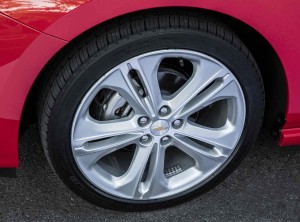
Usually, there is an off button – which kills the auto-stop/start. But the Cruz hasn’t got one. At least, not a physical one. Maybe there is a way to turnout off by scrolling through the various e-menus in the infotainment system but I couldn’t find it.
The good news is you can turn off the Daytime Running Lamps (DRLs) without scrolling through e-menus.
Just rotate the knob to the left of the steering wheel and you will not be driving around on a bright spring day with your headlights burning … and wasting fuel (electricity’s produced by the running engine). It’s be interesting to find out how much gas is wasted by DRLs vs. how much is saved by auto-start/stop. 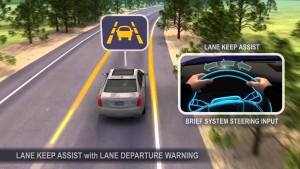
The Cruze has a plush ride and easygoing handling. It is not intended to be a particularly sporty driving car – notwithstanding the available (and Camaro-sounding) Rally Sport package, which is primarily an appearance package. The only mechanical/functional element is an 18-inch wheel/tire ensemble that does firm up the ride some.
The L comes with softer-riding 15-inch wheels. The LT gets 16s; the Premiere goes up to 17s.
Chevy offers an enhanced form of lane departure warning with “intervention” that differs from most systems that merely beep at you if the car wanders across the painted lines in the road. Chevy’s system will also steer for you. It’s weird – a little unsettling – to feel the wheel moving when you aren’t moving it. I am not a huge fan of this. Arguably, a driver unused to it or not prepared for it could over-correct when he feels the wheel pulling to the left and pulls it (manually) back to the right just a bit too much.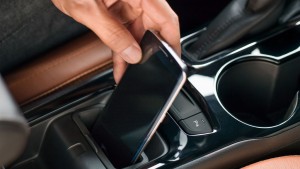
Luckily, the system is optional, part of the Driver Confidence 2 package, which is only available with the Premiere trim.
Unluckily, the genuinely useful wireless sail fawn charger (and a 110-Volt power outlet) are also only available with the Premier trim.
AT THE CURB
While engines are getting smaller, the cars are getting larger.
The new Cruze is almost three inches longer than the old model (183.7 inches vs. 181 inches) and rides on a longer 106.3-inch (vs. 105.7 inch) wheelbase. This makes the new car look almost mid-sized, which it is. The new Cruze’s wheelbase is only slightly less than the wheelbase of last-year’s mid-size Malibu (which has grown to nearly full-size this year) and its interior measurements are virtually the same.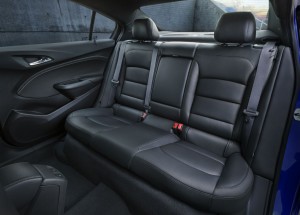
The ’16 Cruz has 42 inches of legroom up front and 36.1 inches of legroom in the back. The Malibu (last year’s model) had 42.1 inches of front seat legroom and 36.8 inches of backseat legroom.
Of course, to put some distance between the new Cruze and the new Malibu (reviewed here) Chevy had to upsize the Malibu, too. The ’16 has 38.1 inches of legroom.
But how about relative to its immediate (compact-sized) rivals?
The Ford Focus has a compact-car backseat, with just 33.2 inches of legroom. The Mazda3 comes closer (35.8 inches) and the Honda Civic has slightly more backseat legroom (37.4 inches) as well as the largest trunk (15.1 cubic feet) of the bunch.
That said, they are all (with the exception of the Ford) roomy cars in both rows and would have qualified as mid-sized cars by the standards of five years ago. But they are still priced like compact cars, which is nice.
THE REST
The manual-equipped L trim is a very attractively priced car that’s also a nicely equipped car. It even comes with standout in-car WiFi and Apple CarPlay and Android Auto. Higher trims get a slightly larger/slightly nicer-looking display, but the base trim’s seven-inch is exceptionally nice for the price. The main needful thing that’s not included is cruise control – which (like the automatic transmission) you’ve got to step up to the much more expensive LS and LT trims to get.
That’s my main gripe with this car – and it’s a gripe I’ve got with all new cars. Call it the Tricky Dick (or Slick Willie, for a more contemporary reference) up-sell. The base trim has almost everything you need except for this one thing (like the automatic or cruise control) but to get that one thing, you have to buy a higher trim with a bunch of stuff you could live without and for which you’ll pay a lot more.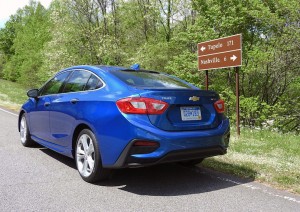
Given the Cruze is positioned as an affordable family car, certain options – like cruise and the automatic – ought to be available a la carte and not part of high-priced packages or available only in the higher-trim versions of the car.
THE BOTTOM LINE
The above gripe aside, this is a better-than-solid value in its class. The manual L especially. But even the higher trims give you more performance (and better mileage) at a lower price in a not-bad-looking wrapper.
Here’s to hoping Chevy can get the diesel past Uncle – and for a price that’s not too high.
EPautos.com depends on you to keep the wheels turning! The control freaks (Clovers) hate us. Goo-guhl blackballed us.
Will you help us?
Our donate button is here.
If you prefer not to use PayPal, our mailing address is:
EPautos
721 Hummingbird Lane SE
Copper Hill, VA 24079
PS: EPautos stickers – new design, larger and magnetic! – are free to those who send in $10 or more to support the site. Please be sure to tell us you want one – and also, provide a mailing address, so we can get the thing to you!


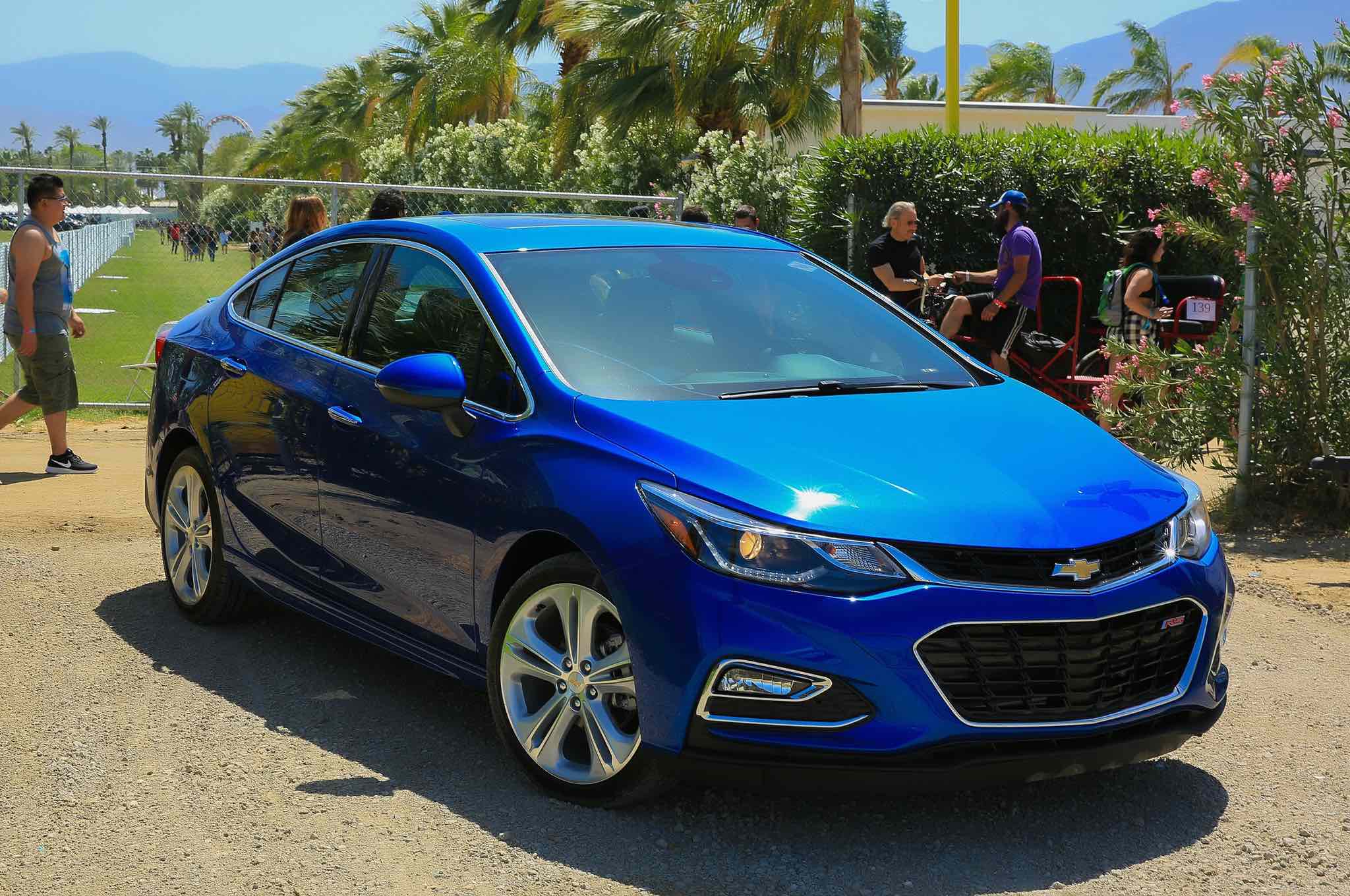


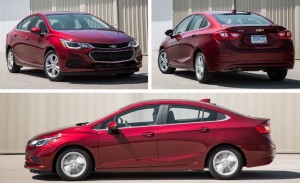
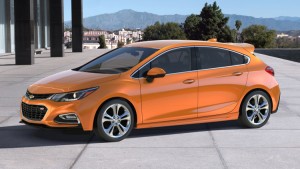











Eric,
I drive a 2014 cruze eco with the 1.4 turbo and manual. Bought it new and enjoy it very much. I participate in the Cruze Forum at cruzeforum.com and posted this article at their site. I enjoyed the article very much…but your “libertarian” leanings brush some of my friends there “the wrong way.”
Just a thought: you might want to encourage your readers to post your articles at such sites and give you an excuse to get into some of those discussions. It might bring more traffic to your site? Just a thought.
I think the previous gen Cruze diesel was optioned up to cover the costs of the necessary environmental plumbing (urea injection etc.). There was a used one at Carmax a while back that I was tempted to pull the trigger on. Funny thing is, I’m noticing that diesel fuel prices are on par or even less than regular gas at some stations. Usually it’s about 50 cents higher. I wonder if that has anything to do with Uncle shaking down VW and refusing to let them sell their diesels here.
Here’s to hoping that “The Donald” will fire the EPA and put an end to all this environmental madness.
“Given the Cruze is positioned as an affordable family car, certain options – like cruise and the automatic – ought to be available a la carte and not part of high-priced packages or available only in the higher-trim versions of the car.”
The base packages are a loss leader-ish deal — get you in the showroom with an advertised price where they won’t make much money, then upsell you to the car you actually want, plus a lot more profit and a few bells and whistles to disguise that the price bump up is mainly profit.
“The main needful thing that’s not included is cruise control – which (like the automatic transmission) you’ve got to step up to the much more expensive LS and LT trims to get.”
You don’t need it if you mainly drive in the city, but if you go on a long road trip through the empty spaces of the West, your right leg can get mighty tired — as I found out recently when it turned out my GF’s car’s cruise control had stopped working sometime prior to setting out on such a trip.